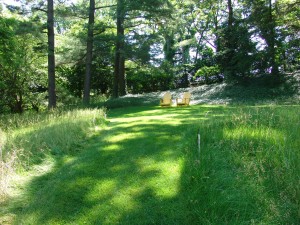It is hard to believe, but August is right around the corner. That means it is time to start thinking about renovating the lawn. We have had such a moist summer, that lawns have not really gone dormant. But, your lawn may have dead spots or weedy areas you want to fix. Maybe your lawn is a complete disaster and you want to undertake a complete renovation. The first step is to decide where you want lawn and where you can choose a different type of landscaping. Just because you have always had a one acre lawn in your front yard, doesn’t mean you have to keep that area in lawn. Think about how you use the lawn—for recreation, for circulation through your landscape, and as a gathering space. Make sure your lawn is actually useable space. What you plant instead of lawn is a topic for another column (one that I have covered before but it can’t be said to much so stay tuned).
For the area you want to be lawn, evaluate its current condition. Is it full of crabgrass? If so, is that because you are mowing the lawn too close? A lawn maintained at 3” usually doesn’t develop crabgrass because the crabgrass seed doesn’t receive the light it needs to germinate. Or do you have weeds because the turfgrass is so patching it isn’t providing any competition against weed incursion. Maybe the soil is so compacted only weeds can grow.
Kill competing weeds before you try to renovate the lawn. This can be accomplished with a non-selective herbicide, like glyphosate or by covering the area with black plastic and smothering the weeds. Black plastic is only practical for small areas and takes longer than using an herbicide. Plants must be actively growing for the herbicide to work. If you use glyphosate, wait 10 days to 2 weeks to make sure the glyphosate gets translocated throughout the root systems of the existing vegetation.
Take this opportunity to correct soil problems. Take a soil sample to find out if your soil is deficient in nutrients or if the pH is too low. Correct a low pH by adding lime. Add nutrients as recommended by your soil test results. Core aerate the soil if it is compact. Core aeration will also facilitate good seed soil contact once you reseed. Also, consider adding some type of organic matter, such as mushroom soil, manure, composted yard waste to improve the soil structure. Add a starter fertilizer (containing no more than ½ pound of nitrogen per 1000 square feet of lawn). Once the site if fully prepped, you are ready to seed.
Only seed that contacts soil will germinate, so having open soil or compost is critical for a successful lawn renovation. Select a turfgrass that works well in your location. In Sussex County, Delaware, we recommend using only tall fescue cultivars. In New Castle County, you can also grow perennial ryegrass and Kentucky bluegrass, but tall fescue is the toughest and most drought tolerant of our cool season grass species. If your lawn is shady (too much shade means you should select a groundcover other than turf), choose red fescue in a blend. Spread seed using a slit seeder and by simply broadcasting seed over the site.
Add a light layer of straw or salt marsh hay as mulch on top of the seed. This will help keep the soil moist and control some of the weeds that might compete with your newly establishing turf. Keep newly seeded lawn moist with a sprinkler, soaker hoses or irrigation system. If you have perennial ryegrass in the mix, expect germination in 4 to 5 days. Tall fescue can take up to 10 days to germinate. You can cut the grass for the first time when it reaches 4 – 4 1/2 inches. Cut off 1 – 1 1/2 inches to bring it back to 3 inches. Be sure to use a sharp mower blade when cutting newly seeded grass. Once you have cut the grass a few times, you can add about one pound of nitrogen per 1000 square feet. Don’t forget to keep the new grass moist. By this time we should be into September and nights should be getting cooler.
If you only have a few bad patches in a lawn, you may not need to undertake a complete renovation. Kill perennial weeds if they are a problem and rake out the area so soil is exposed. Spread the seed and continue as above with straw mulch and watering. Spreading grass seed on top of existing vegetation with no soil exposed is a waste of time. Late summer and early fall is the best time to renovate the lawn because soil temperatures are still warm enough to promote good germination, but air temperatures are beginning to cool, promoting growth of cool season turfgrasses.
Be sure to follow me on Instagram (sbartonhort) for gardening tips and interesting horticultural news.


